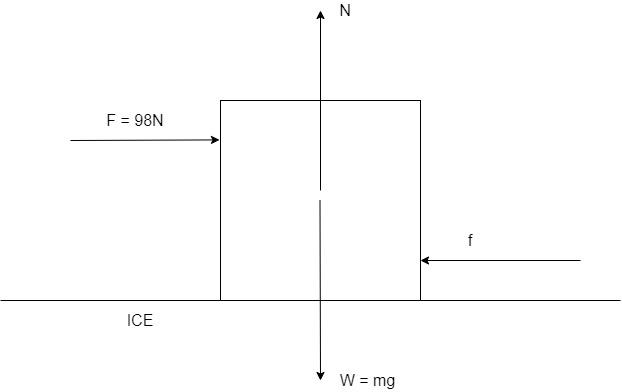
A force of 98 newtons is required to just drag a body of mass 100 kg on ice. The coefficient of friction will be
A. 0.98
B. 0.89
C. 0.49
D. 0.10
Answer
520.2k+ views
Hint: The friction basically means, a resistance or obstruction offered to the application of a force against another surface.
Mathematically, the frictional force is directly proportional to the normal reaction provided by the surface for the body.
Frictional force
$F_s \propto N$
By removing the sign of proportionality and introducing a constant, we have:
$F_s = \mu N$
Where $\mu$ is called the coefficient of friction.
Complete step by step answer:
Let us consider the body of mass 100 kg on ice

Here, there are 4 forces acting on the block. They are
i) Weight of the body, $W = mg$
ii) Normal force acted by the surface, $N$
iii) Force applied to move, $F = 98N$
iv) Frictional force, $f = \mu N$
Since the body just starts to move, the force applied to move the body is equal to the frictional force acting on it by the surface.
We see that the body is in equilibrium with all the forces acting on it. Hence,
Vertical forces: $W = N$
Horizontal forces: $F = f$
Given, mass m = 100 kg.
Weight, $W = mg = 100 \times 9.8 = 980N$ (assuming the acceleration due to gravity, $g = 9.8m{s^{ - 2}}$)
This weight is equal to the normal:
$W = N = 980N$
Also, we have
$F = f = \mu N$
Given, $F = 98 N$.
Substituting the values of F and N, we have
$\Rightarrow F = \mu N $
$\Rightarrow 98 = \mu \times 980 $
$\Rightarrow \mu = \dfrac{{98}}{{980}} = \dfrac{1}{{10}} = 0.1 $
Therefore, the coefficient of friction is, $\mu = 0.1$. Hence, the correct option is Option D.
Note:
The students should note that the force applied here, is equal to the kind of friction called impending friction. Impending friction is the friction applied to the body when the body is just about to start moving. Any applied force that is lesser than this particular value of impending friction, is termed as static friction.
Mathematically, the frictional force is directly proportional to the normal reaction provided by the surface for the body.
Frictional force
$F_s \propto N$
By removing the sign of proportionality and introducing a constant, we have:
$F_s = \mu N$
Where $\mu$ is called the coefficient of friction.
Complete step by step answer:
Let us consider the body of mass 100 kg on ice

Here, there are 4 forces acting on the block. They are
i) Weight of the body, $W = mg$
ii) Normal force acted by the surface, $N$
iii) Force applied to move, $F = 98N$
iv) Frictional force, $f = \mu N$
Since the body just starts to move, the force applied to move the body is equal to the frictional force acting on it by the surface.
We see that the body is in equilibrium with all the forces acting on it. Hence,
Vertical forces: $W = N$
Horizontal forces: $F = f$
Given, mass m = 100 kg.
Weight, $W = mg = 100 \times 9.8 = 980N$ (assuming the acceleration due to gravity, $g = 9.8m{s^{ - 2}}$)
This weight is equal to the normal:
$W = N = 980N$
Also, we have
$F = f = \mu N$
Given, $F = 98 N$.
Substituting the values of F and N, we have
$\Rightarrow F = \mu N $
$\Rightarrow 98 = \mu \times 980 $
$\Rightarrow \mu = \dfrac{{98}}{{980}} = \dfrac{1}{{10}} = 0.1 $
Therefore, the coefficient of friction is, $\mu = 0.1$. Hence, the correct option is Option D.
Note:
The students should note that the force applied here, is equal to the kind of friction called impending friction. Impending friction is the friction applied to the body when the body is just about to start moving. Any applied force that is lesser than this particular value of impending friction, is termed as static friction.
Recently Updated Pages
Master Class 11 Economics: Engaging Questions & Answers for Success

Master Class 11 Accountancy: Engaging Questions & Answers for Success

Master Class 11 English: Engaging Questions & Answers for Success

Master Class 11 Social Science: Engaging Questions & Answers for Success

Master Class 11 Biology: Engaging Questions & Answers for Success

Master Class 11 Physics: Engaging Questions & Answers for Success

Trending doubts
1 ton equals to A 100 kg B 1000 kg C 10 kg D 10000 class 11 physics CBSE

Difference Between Prokaryotic Cells and Eukaryotic Cells

One Metric ton is equal to kg A 10000 B 1000 C 100 class 11 physics CBSE

1 Quintal is equal to a 110 kg b 10 kg c 100kg d 1000 class 11 physics CBSE

Proton was discovered by A Thomson B Rutherford C Chadwick class 11 chemistry CBSE

Draw a diagram of nephron and explain its structur class 11 biology CBSE




